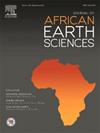Seismic interpretation, structural and property modelling of Cenomanian siliciclastic/carbonates Abu Roash reservoirs in the El Diyur field (Abu Gharadig Basin, NW Desert, Egypt): Implications for reservoir architecture, distribution and evaluation
IF 2.2
4区 地球科学
Q2 GEOSCIENCES, MULTIDISCIPLINARY
引用次数: 0
Abstract
This study presents a comprehensive integration of seismic and petrophysical assessment of the Abu Roash “G" Member in the El Diyur Oil Field, east Abu Gharadig Basin, aiming to characterise reservoir heterogeneity and evaluate hydrocarbon potential in a complex faulted setting. The overall integration of seismic, structural, and petrophysical data was employed to delineate the reservoir's structural configuration, lithological variations, and lateral distribution of reservoir properties. Seismic interpretation revealed a sheet-like geometry with the northward-dipping reflectors intersected by a major east-west trending, south-dipping normal fault (F1) and a minor subsidiary fault (F2). Fault-dependent closures created by F1 were identified as the key structural traps for hydrocarbon accumulation. Petrophysical evaluations highlighted distinct lithological variations across the Abu Roash “G-10,” “G-15,” and “G-20″ zones, with G-10 dominated by reservoir sandstones, G-15 by bioclastic limestone, and G-20 by calcareous sandstone interbedded with siltstone. Key reservoir attributes, including effective porosity, water saturation, and clay volume, exhibited lateral variations influenced by both facies and structural controls. Structural and facies modelling, incorporating fault and horizon reconstruction, underscored the impact of structural configuration on reservoir quality and hydrocarbon distribution. Depositional models suggested deltaic and tidal settings, which significantly influenced porosity and water saturation profiles. The outputs emphasise the critical role of integrated structural-petrophysical modelling in understanding reservoir heterogeneity and hydrocarbon accumulation, providing valuable insights for future exploration and development strategies in the El Diyur Oil Field and similar oil fields.
El Diyur油田(Abu Gharadig盆地,埃及西北部沙漠)Abu Roash储层的地震解释、结构和性质建模:对储层结构、分布和评价的影响
本研究对Abu Gharadig盆地东部El Diyur油田Abu Roash“G”段进行了地震和岩石物理综合评价,旨在表征储层非均质性并评估复杂断裂环境下的油气潜力。综合地震、构造和岩石物理资料,圈定了储层的构造形态、岩性变化和储层物性的横向分布。地震解释揭示了一个向北倾斜的反射体与一条东西向的主要正断层(F1)和一条较小的附属断层(F2)相交的片状几何结构。F1形成的断层依赖闭包被认为是油气聚集的关键构造圈闭。岩石物理评价突出了Abu Roash“G-10”、“G-15”和“G-20″”带的明显岩性差异,其中G-10带以储层砂岩为主,G-15带以生物碎屑灰岩为主,G-20带以钙质砂岩与粉砂岩互层为主。储集层的关键属性,包括有效孔隙度、含水饱和度和粘土体积,受到相和构造控制的横向变化。结合断层和层位重建的构造和相模型强调了构造形态对储层质量和油气分布的影响。沉积模式显示三角洲和潮汐背景,这对孔隙度和含水饱和度剖面有显著影响。研究结果强调了综合构造-岩石物理建模在理解储层非均质性和油气聚集方面的关键作用,为El Diyur油田和类似油田的未来勘探和开发策略提供了有价值的见解。
本文章由计算机程序翻译,如有差异,请以英文原文为准。
求助全文
约1分钟内获得全文
求助全文
来源期刊

Journal of African Earth Sciences
地学-地球科学综合
CiteScore
4.70
自引率
4.30%
发文量
240
审稿时长
12 months
期刊介绍:
The Journal of African Earth Sciences sees itself as the prime geological journal for all aspects of the Earth Sciences about the African plate. Papers dealing with peripheral areas are welcome if they demonstrate a tight link with Africa.
The Journal publishes high quality, peer-reviewed scientific papers. It is devoted primarily to research papers but short communications relating to new developments of broad interest, reviews and book reviews will also be considered. Papers must have international appeal and should present work of more regional than local significance and dealing with well identified and justified scientific questions. Specialised technical papers, analytical or exploration reports must be avoided. Papers on applied geology should preferably be linked to such core disciplines and must be addressed to a more general geoscientific audience.
 求助内容:
求助内容: 应助结果提醒方式:
应助结果提醒方式:


